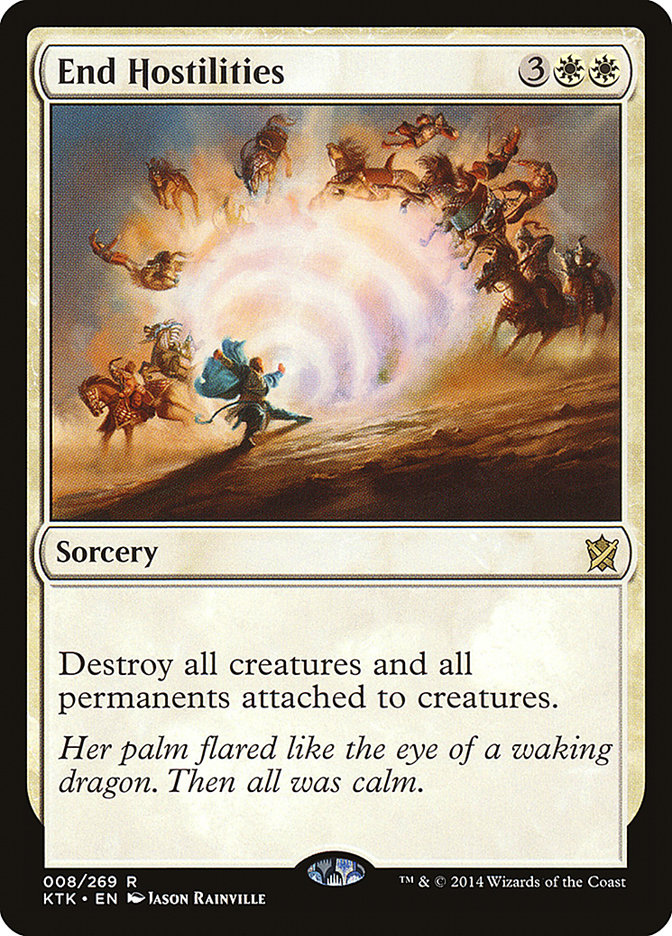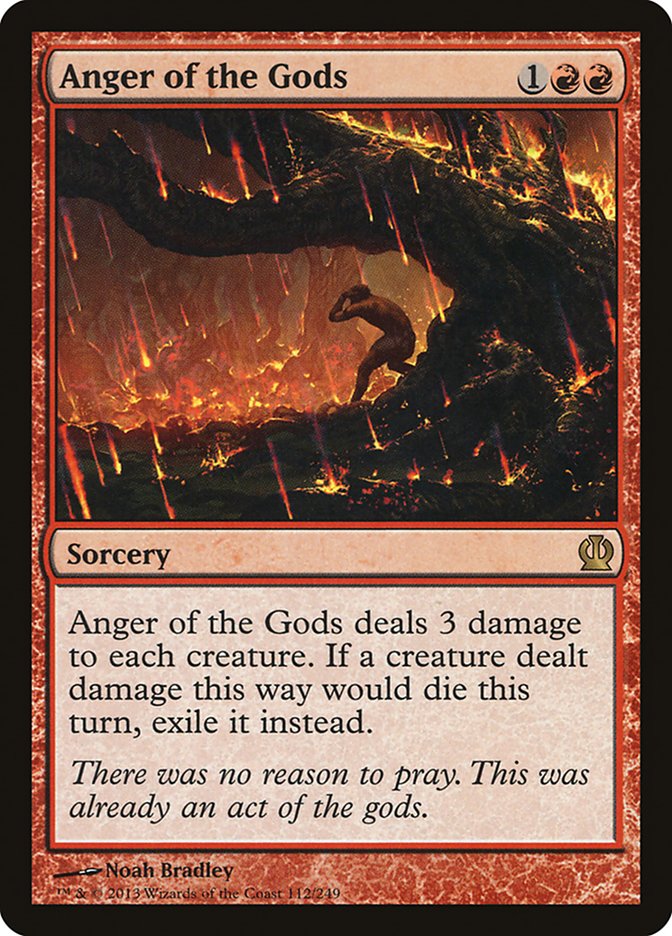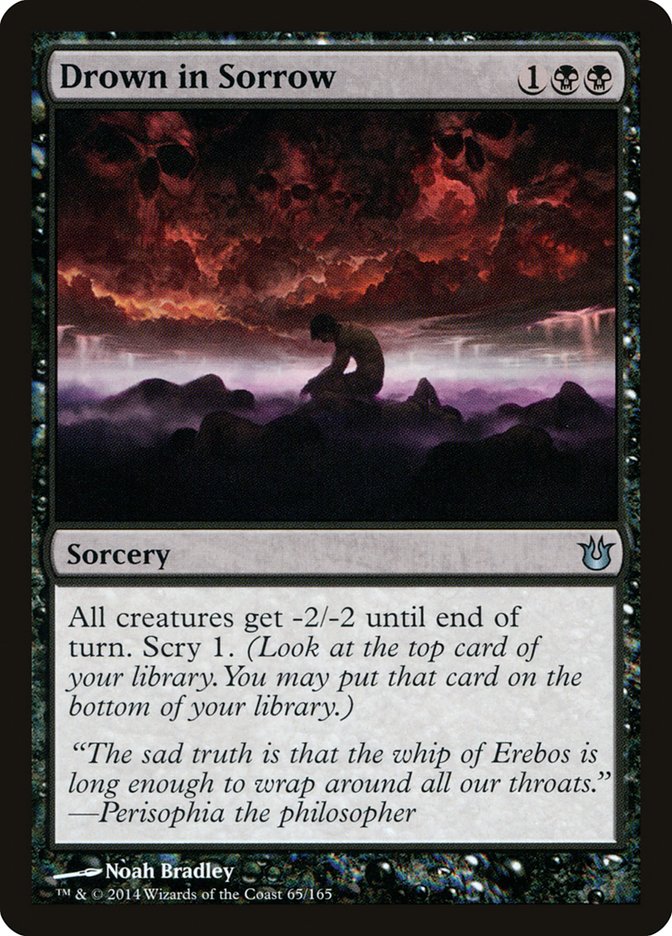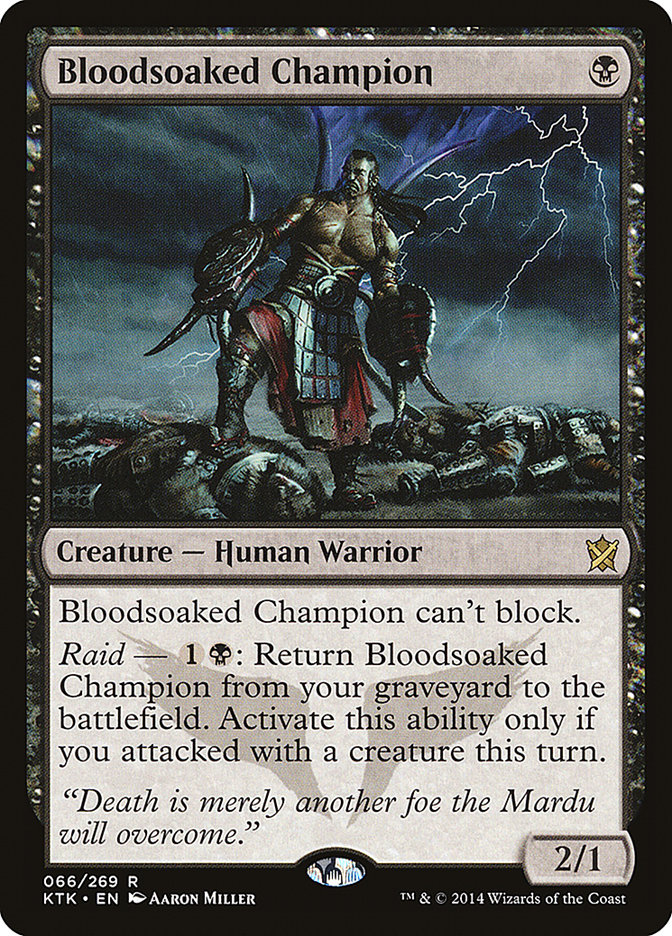Today I will discuss how I’ve gotten started building decks for the new Khans of Tarkir Standard format.
But, first I’d like to briefly touch upon my experience at the Khans of Tarkir Prerelease at my local game store where I took first place in a 60 person
event and won the amazing Nerf Garruk’s Axe.
I was very happy with my decision to fight with the mighty Abzan tribe.
Creatures (15)
- 1 Herald of Anafenza
- 1 Rattleclaw Mystic
- 1 Abzan Guide
- 1 Ainok Bond-Kin
- 1 Chief of the Scale
- 2 Mer-Ek Nightblade
- 1 Abzan Falconer
- 1 Bloodsoaked Champion
- 1 Timely Hordemate
- 1 Dazzling Ramparts
- 1 Seeker of the Way
- 1 Disowned Ancestor
- 1 Kheru Bloodsucker
- 1 Mardu Hordechief
Lands (17)
Spells (8)

The deck is basically just a straight B/W Outlast deck that splashes two green morphs off of four mana fixers. I chose Abzan for the prerelease because it
seemed that the outlast mechanic ought to be particularly good in sealed deck where the games tend to go pretty long, and having something extra and
powerful to do with mana ought to be a big deal.
Wow, was that statement spot on in my experience.
Maybe I’ve just got Slivers on the brain since I built my Sliver Hivelord Commander deck, but the outlast creatures very much reminded me of playing a
Sliver deck in sealed because many of them grant an ability to any other creature with a +1+1 counter on it.
Form of: SLIVER!!!
The best card in my deck (and I had three copies!) was Feat of Resistance because it could add a +1/+1 counter to a non-outlast creature and thus grant the
new creature access to all of the abilities of my other outlast creatures.
While I haven’t gotten to draft Khans of Tarkir yet, I am fairly certain that when building a sealed deck for this format I will be hoping to open lots of
creatures with the outlast ability in my pool. While the ability probably isn’t as good in a faster Limited format like draft, in a slower one like Sealed
it seemed to be really dominant.
Okay, so moving on from my awesome sealed pool at the prerelease and onto a little bit of Constructed discussion. One of my all-time favorite times over
the course of the Magic year is when one block rotates out of Standard and a new one comes out. For the span of a couple of weeks it really is a deck
builder’s paradise.
The problem with a deck builder’s paradise is that most people are not super savvy deck builders and can’t always fully partake in brewing, building, and
tuning. The problem isn’t that building decks is some kind of rocket science that only geniuses can figure out, but rather that many people don’t really
know how to get started.
The easiest place to get started when trying to brew decks and figure out what is going to be good is to start with what is the most obvious thing to be
doing. Decks that are simple, linear, straightforward, and heavily influenced by cards from the previous block are often a great place to start.
I can’t tell you how many times I’ve lived this exact experience over the course of the past few weeks.
“Hey, Brian I have a sick deck for Khans Standard.”
“Cool. What are you playing?”
“Sultai Control.”
“Cool. Want to play a couple of games?”
“Sure.”
We then proceed to play eight games against three of my “stock” Khans deck with the stock decks easily winning every game.
One of the biggest problems that inexperienced players have is that they don’t start at the beginning, but rather skip ahead of themselves when building
decks.
For instance, how is it possible to actually build an efficient control deck when you don’t even know what the aggro decks look like yet? It is extremely
difficult to accomplish such a goal, as it is difficult to make reactive cards match up well against an unknown field of decks.
I always start my approach to deck building by trying to figure out what everybody already knows. What are the decks that are so obviously good that everyone will know about them? In the case of this format I think that there are three pretty clear “easy” decks that we can look at to gain some
perspective.
The first deck is Mono-Green Devotion:
Creatures (29)
- 1 Hornet Queen
- 4 Elvish Mystic
- 4 Polukranos, World Eater
- 1 Nylea, God of the Hunt
- 4 Sylvan Caryatid
- 2 Arbor Colossus
- 1 Nylea's Disciple
- 4 Voyaging Satyr
- 4 Courser of Kruphix
- 4 Genesis Hydra
Planeswalkers (5)
Lands (24)
Spells (2)

Mono-Green Devotion is the number one deck on my radar at the moment because it is linear, powerful, and already exists. Mono-Green Devotion was already
good in old Standard, and it doesn’t really lose anything of note, which means that it is a great place to start when approaching new Standard.
The deck is good because it was already objectively powerful, and with a smaller card pool and in an undefined metagame, the deck should really be
considered a legitimate threat.
Mono-Green Devotion makes tons of mana and ramps out powerful and overwhelming threats with the help of Nykthos, Shrine to Nyx and Voyaging Satyr. It isn’t
uncommon for the deck to be able to produce thirty or forty mana if the opponent can’t interact with it in the proper ways. And any deck that can do
something like that on the sixth or seventh turn is worth understanding and being prepared for!
The number one question that I ask people when they say they have a deck or a brew they’ve been working on is “Have you taken the mono-green challenge?”
Meaning, “Have you played against Mono-Green Devotion yet, and how does your deck do against it?”
You’d be surprised how many brews simply roll over and die against a deck like this one. It’s important to have a plan and to make sure that you have
enough ways of interacting with a deck like this before you take your brew to a touranment!
What ever happened to Supreme Verdict?
Supreme Verdict was the number one card at dealing with devotion decks, and with it out of the format there is going to be a lot of room for Mono-Green
Devotion to be even better than it was before. With that said, there are still plenty of mass removal spells to contain the mana acceleration of the deck,
which is the best way to go about beating it.
The next deck that I built in my gauntlet of new Khans of Tarkir decks was Rabble Red.
Creatures (26)
- 4 Foundry Street Denizen
- 4 Akroan Crusader
- 4 Firedrinker Satyr
- 2 Mogis's Warhound
- 4 Eidolon of the Great Revel
- 4 Goblin Rabblemaster
- 4 Monastery Swiftspear
Lands (20)
Spells (14)

Rabble Red is another one of those linear decks that are so powerful that they can’t be denied. The deck is very fast, and if your opponent doesn’t have
the right kinds of cards to interact with it, they’re going to be in a whole world of pain.
Decks like this are the kind of deck that the majority of players don’t test against nearly enough and then those same players complain endlessly about
losing to these types of decks in tournaments. “My opponent got so lucky, etc.” When in fact, most of the time the red deck is going to take the day
because it attacks from an angle that many midrange decks are not prepared to handle.
If you want your brew to beat decks like these, look for cards that interact quickly for one, two, and three mana. Most of the other stuff is going to end
up being too late and too slow, especially if you are not making plays that matter in the first few turns of the game.
There is a reason that Goblin Rabblemaster has gone from being an inexpensive card to a straight up money card, and I expect that aggressive Rabblemaster
decks will be a cornerstone of this new Standard format.
The other deck that was part of my first wave of decks in my gauntlet was Mono-Black Aggro. It’s a pretty solid deck, although I believe that people will
likely play more red decks than black decks.
That being said, people will have Mono-Black decks at tournaments so it would be smart to be ready for them.
Creatures (26)
- 4 Tormented Hero
- 4 Mogis's Marauder
- 4 Pain Seer
- 3 Herald of Torment
- 3 Spiteful Returned
- 4 Gnarled Scarhide
- 4 Bloodsoaked Champion
Lands (22)
- 22 Swamp
Spells (12)

I actually like this deck quite a bit!
Unbelievable card!
Bloodsoaked Champion is one of the absolute best cards that I’ve played with out of Khans of Tarkir so far. It is exactly the kind of card that an
aggressive deck like this wants because it pushes through damage early, but can incidentally die and come back into play as the game grinds on. Bloodsoaked
Champion is the best card in the deck by a mile.
I like that the deck is super aggressive but also has some really nice options to interact with opposing decks like Ulcerate and Thoughtseize. Also, if you
haven’t gotten killed by a Mogis’s Marauder in Constructed yet, it happens to us all eventually…
I hope that this mini-gauntlet helps all of those up start deck builders out there. When I’m brewing new decks I always try to keep in mind what the
powerful, popular, decks out there are and make sure that what I’m putting together is going to have a chance against those other known “good decks.” If
you test against three decks before the new Khans Standard format, I believe players could do a lot worse than to test against decks like these.
Everybody wants to build the next sweet five color control deck or bizarre combo deck, but everything starts at the beginning of the format. Have you taken
the Mono-Green Challenge? Can you beat Rabble Red? Can you fight against Mono-Black one drops?
If you can beat linear decks like these, chances are that your brew will be able to beat a lot of stuff in the format. Whatever you do, keep it real and
fight against the real enemies!
I’ll be at the Open Series in Indianapolis this weekend. I haven’t perfected my brew yet, but at least I have my sights on what I’m trying to beat!






